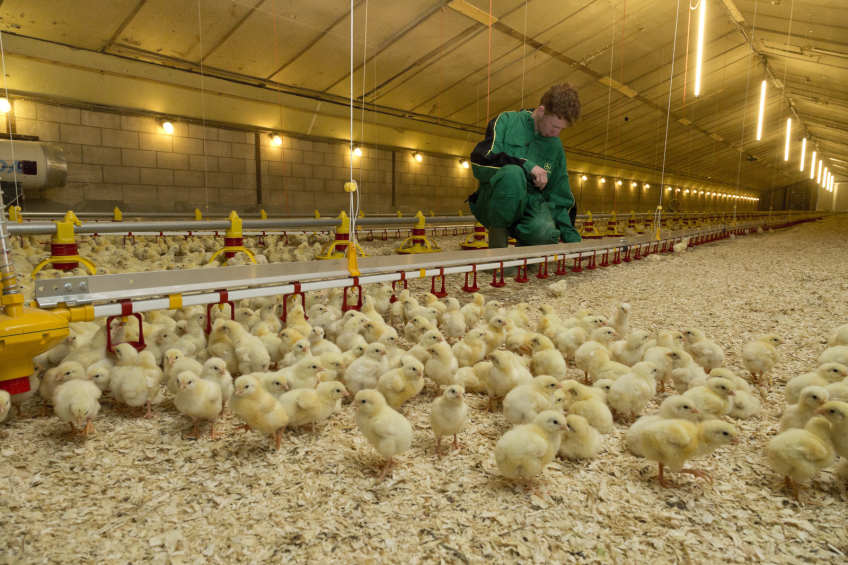Dry litter largely depends on management skills

The first part of this article was published in the previous edition of World Poultry. Besides understanding the do’s and don’ts when placing day old chicks on a clean and dry floor, skilled management is needed to keep the birds comfortable on dry litter.
By Ken Marshall, South Africa
(The first part of this article can be found here.)
Two main systems apply regarding dealing with poultry litter. The first, and I believe the best, is to use virgin bedding for each new crop of chicks. The second, is to re-use the litter for a subsequent placement of day of chicks. Personally I do not advocate the reuse of litter, it is opening the door to problems and if not a necessity, cut it out!! Why make the job more difficult? There is too much to lose.
Person’s nose
What are the main factors causing wet litter? Improper ventilation control right through the cycle; not enough ventilation from day one; bad choice of litter; not having the correct equipment to guide you.
The average person’s nose is 1.6-1.7 m above bird height. One may think that it all looks correct, however you need to know exactly what the conditions are to make instant decisions to change the environment in the houses, if necessary. If you can smell ammonia at 1.7 m above floor level, what do you think it is like for the chicken at anything from 10-30 cm (4-12 inches)? How many companies employ experienced personnel who have the ability to analyse the computer data being produced daily from their in house computer systems from a central control point?
It’s all about management. Have you got the knowledgeable people in these positions who can make the correct decisions before these problems occur? You can see them coming if you know what to look for. The bottom line is “Have they learned the required skills”? If yes, that is great. Has everything been set up correctly to monitor the litter moisture percentage on a several times daily routine? These are points that can cost a lot of money if a proper system is not in place. At the end of the day, it is all about prevention and being one step ahead, like stockmanship. The ability to see what the bird/chick needs before it actually shows you.
Flushing nipples daily
A dirty water detection sensor is a useful addition to your arsenal in combatting wet litter. Nipples leak! What have you got in place to reduce this occurrence? From the end of the first week, nipple lines should be flushed daily, and checked after the process that all lines are operating correctly, also the flow rates and make adjustments where necessary. This requires personnel to do this and it also needs to be done seven days per week.
Look at the litter moisture percentages in all your chicken houses from day 7. This will give you a good guide and keep you on track to avoid any major wet litter problems. By day 14 the damage has already been started, unless you have everything in place to prevent the bedding from caking. This could be only one house of 10,000 birds or it could be several hundred each of 40,000. It is all relative to your business size and of vital importance as it has a direct effect on issues such as health, mortality, FCR, bird weight, weight for age-lifting age-house workers health, not to forget the chickens health!
Prevention or curing
As the old phrase says ‘prevention is better than cure’. Do you know what you are starting with? Many producers or contractors accept what they are given and do not really know in a lot of instances, what is really required, or else they would be doing it professionally already.
White (soft) wood shavings are recommended, red wood is from harder wood and does not absorb moisture very well, in comparison to soft white. In order to know where you stand with your litter condition at any given time, you will need a moisture tester to show the moisture percentage in the bedding (litter) after the litter has been levelled throughout the house. This should be taken even before the chicks are placed. In some cases I have seen figures of 20%.
Best litter choice
To summarise, we need to start with the best litter which will absorb the most moisture. What are the factors causing the wood shavings (litter) to take up moisture in a relatively short period of 7 to 14 days?
We need the initial bedding to be low in moisture <10%. If it has an initial 20% once the house is up to temperature 34-35˚C, it may be even 38˚C at the top of the ceiling and the floor temperature of 32˚C on top of the bedding before the chicks arrive. This temperature will reduce the moisture content, especially if the bedding is turned before the house is set up to accept the chicks. Here several pointers in the house itself can play a vital role.
Ensure selected sites
The use of under floor heating is a prerequisite in cold climates. Ensure that after the sites have been selected, that the maximum height of the water tables are known as this can increase underground moisture levels and result in lower temperatures, and higher humidity in summer which can put an extra load on the ventilation system, especially if already overloaded.
There is also the added threat of higher humidity causing stress on chicks and growing broilers. Perhaps a local geologist would be beneficial. It could show you that your damp proof course needs to be a double or tipple gauge over the normal.
Source: World Poultry, Volume 30. No. 9, 2014













